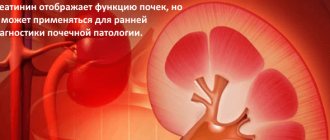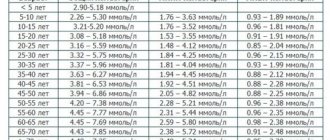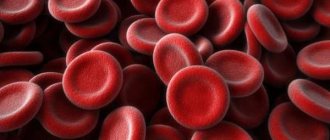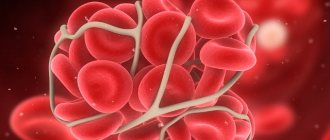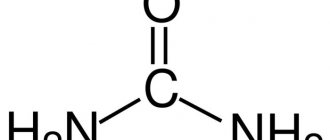Why is cholesterol so important?
Cholesterol is present in cell membranes. It ensures the construction of cellular structures in the body and performs the following functions:
- Takes part in metabolism;
- Participates in the functioning of the kidneys and bone marrow;
- Helps synthesize hormones: testosterone, cortisol, estrogen;
- Promotes the synthesis of vitamin D;
- Cholesterol contained in a nursing mother's milk helps the infant develop.
Cholesterol metabolism
“Bad” and “good” cholesterol
In the human body there is little total cholesterol in its pure form. It is mainly found in substances called lipoproteins. Such elements have low or high density. If the density is high, then we are talking about “good” cholesterol - HDL, and if it is low, then these are “bad” lipoproteins - LDL.
Bad and good cholesterol
HDL plays an important role in the normal functioning of the body, since these fats protect blood vessels from the accumulation of low-density cholesterol growths in them. HDL moves “bad” cholesterol to the liver, where it is broken down.
Many people believe that cholesterol is a big problem in men. But this opinion is unfounded, because only LDL is harmful, which leads to the appearance of atherosclerotic formations in blood vessels.
Plaques in blood vessels
Possible consequences of high cholesterol
Now that we know how much cholesterol men should have normally, depending on age, and the normal level of triglycerides in the blood, let’s look at why the level of the above norms is critically dangerous.
With age-related hypercholesterolemia, total cholesterol increases primarily due to LDL, which is considered a harmful fraction. So LDL is elevated: what does that mean?
Such cholesterol (bad) has the property of settling on the vascular walls, sticking molecule to molecule, thereby forming cholesterol plaques. Over time, the processes lead to the occurrence of vascular pathologies, elements of ischemia and other cardiovascular disorders. The main outcome of this pathogenesis is atherosclerosis. This, in turn, can lead to complications such as angina pectoris, arterial hypertension, heart attacks, strokes, and coronary heart disease.
Treatment for lipid disorders can and should be done, but only after a full examination and consultation with a specialized doctor , who, based on the collected tests and data from other special studies, will make a diagnosis and prescribe appropriate therapy.
Causes of high cholesterol in men
Among the typical reasons that provoke the growth of harmful lipoproteins (LDL) in males are the following:
- Poor quality, poor nutrition, consumption of large amounts of fatty, difficult to digest food;
- Low physical activity, especially for those who, due to their work, are forced to sit in one place for a long time;
- Excess body weight;
- Thyroid dysfunction;
- Dangerous habits (alcohol, cigarettes);
- Heredity factor;
- Age after fifty;
- High blood pressure;
- Diseases of the liver, kidneys, spleen;
- Frequent emotional swings, nervous breakdowns.
Doctors advise men who are over 40 years old to monitor their blood cholesterol levels. This applies to every male, regardless of disease or lifestyle.
The fact is that over the years, irreversible changes occur in a man’s body, and after the age of 40, their testosterone production decreases. This is a natural process called in medicine age-related androgen deficiency. Changes in hormonal levels lead to the development of pathological processes, this can be simple obesity, or more severe heart disease.
Man after forty
Quite rarely, laboratory test results show low LDL levels. If blood cholesterol in men is below normal, then this process may be due to a lack of vitamins due to an improper diet, diseases of the thyroid gland and liver, anemia, serious problems in the gastrointestinal tract, which makes the absorption of nutrients in the body much worse.
Men with cardiovascular diseases
Slightly different indicators have been established for those men who suffer from pathologies of the heart and blood vessels, or have suffered a heart attack or stroke. In this case, the readings should not exceed 2.5 mmol/liter. Constant monitoring of blood cholesterol levels is necessary in order to avoid relapses and prevent the progression of an existing disease.
If a man is relatively healthy, but falls into a risk group (he has a congenital predisposition to pathologies of the heart and blood vessels, is overweight, smokes or drinks frequently), then he should also constantly monitor the level of cholesterol in his blood - ideally, if the levels do not exceed 3 .3 mmol/liter.
Blood cholesterol levels in men
To determine the amount of cholesterol, you need to undergo a special biochemical examination, that is, take a blood test for total cholesterol. This procedure is performed in the morning, on an empty stomach. Before donating blood, it is better not to consume food or alcohol for 12 hours.
The test may be recommended for patients with:
- Diabetes mellitus;
- Prolapse of the kidneys;
- Problems with the thyroid gland;
- Cirrhosis of the liver.
The cholesterol level in men is determined by age. The table with optimal values shows average figures showing normal cholesterol. Therefore, the attending physician should always take into account the individual characteristics of the patient.
There is an analysis that separately identifies the values of high-density and low-density cholesterol. These substances are measured in mmols per liter of blood. The number showing total cholesterol is the sum of “good” and “bad” lipoproteins.
A special table shows cholesterol levels in men by age. According to doctors, in the blood of men after 50 years, the percentage of this substance stops increasing and even gradually decreases.
Table
There is another type of fat present in the blood plasma - triglycerides. Their level also needs to be controlled. In an adult patient (25-40 years old), this indicator should not exceed 2 mmol per liter. As men age, triglyceride levels increase. And in the blood of men after 60 years, the ratio of fats evens out.
Cholesterol table: norm for men by age
Before looking at the table, let's figure out what these words and letters mean - both in the table of contents and in the results of the blood test? Where capillary blood (i.e. “from a finger”) is used as a biomaterial for studying and identifying the values of total cholesterol. And in terms of lipid profile (lipid profile)
– only venous (on an empty stomach).
General HS
Total cholesterol
(cholesterol) or Cholesterol total (in the USA, Canada and Europe). This fat-like (waxy) substance is vital for our body. Since it is actively involved in the production of hormones (and vitamin D), digestion of food and the formation of nerve fibers. It is also the most important component of the cell membrane and plays an important role in the functioning of the brain and immune system (protecting us from cancer).
However, with its excess (in particular, in the LDL fraction, described a little below), the risks of the formation of cholesterol plaques (i.e. the development of atherosclerosis)
).
Which ultimately leads to blockage (occlusion) of blood vessels or arteries, which means a heart attack or stroke. ( SEE VIDEO AT BOTTOM OF PAGE - 43 sec
).
Normal values of Total cholesterol for men should be less than 5.18 mmol/l (or below 200 mg/dl)
Being a fat/alcohol-like substance (as mentioned above), cholesterol is completely insoluble in water. Therefore, for transportation through the circulatory system, it is “packed” into a protein shell consisting of apolipoproteins (A1 and B). As a result, complexes are formed, which doctors call lipoproteins (high / low / very low and intermediate density).
LDL cholesterol
Low Density Lipoprotein Cholesterol
(other names: LDL, LDL-C, beta-lipoproteins, beta-LP). Foreign abbreviation - LDL, LDL-C (Low density lipoprotein, low-density lipoprotein cholesterol). They are the main transporters of cholesterol in the blood, as well as the main defenders of the body against deadly bacterial toxins. However, it is popularly called “bad cholesterol”. Due to its poor ability to form atherosclerotic plaques on the walls of blood vessels or arteries. We wrote about their harm a little higher.
Optimal LDL cholesterol levels for healthy men should be less than 2.59 mmol/L (or less than 100 mg/dL). The values are close to optimal: 2.59 - 3.34 mmol/l (or 100 - 129 mg/dl). For those suffering from coronary artery disease or diabetes mellitus - less than 1.81 mmol/l (or below 70 mg/dl).
HDL cholesterol
High Density Lipoprotein Cholesterol
(other names: HDL, HDL cholesterol, alpha cholesterol). Foreign abbreviation – HDL, HDL-C, HDL Cholesterol (High-density lipoprotein cholesterol, High density lipoprotein). Unlike their “predecessors”, they are proudly called “good” cholesterol. Since they are the ones responsible for transporting waste fats (LDL, LPPP) back to the liver. Where they are synthesized into bile acids and then excreted from the body through the intestines.
Excellent HDL cholesterol levels in men are in the range: 1.0 – 1.55 mmol/l (or 40 – 60 mg/dl). Lower values increase the risk of developing atherosclerosis or cardiovascular diseases. Higher values, on the contrary, are called by doctors “longevity syndrome.”
Units:
in the USA – mg/dl. (i.e. in milligrams per deciliter), and in Canada, Europe and Russia – mmol/l (i.e. millimoles per liter). If necessary, recalculation “back and forth” is carried out using the following formulas:
- cholesterol (mmol/l) = cholesterol (mg/dl) x 0.0259;
- cholesterol (mg/dl) = cholesterol (mmol/l) × 38.665.
Or use laboratory calculators (located on our website) for conversion: convert HS General
,
recalculate HDL cholesterol
,
convert LDL cholesterol
.
| Age: | General HS: | LDL (LDL) | HDL (HDL) |
| 2.95 – 5.25 | |||
| 5 — 10 | 3.13 – 5.25 | 1.63 – 3.34 | 0.98 – 1.94 |
| 10 — 15 | 3.08 – 5.23 | 1.66 – 3.34 | 0.96 – 1.91 |
| 15 — 20 | 2.91 – 5.10 | 1.61 – 3.37 | 0.78 – 1.63 |
| 20 — 25 | 3.16 – 5.59 | 1.71 – 3.81 | 0.78 – 1.63 |
| 25 — 30 | 3.44 – 6.32 | 1.81 – 4.27 | 0.80 – 1.63 |
| 30 — 35 | 3.57 – 6.58 | 2.02 – 4.79 | 0.72 – 1.63 |
| 35 — 40 | 3.63 – 6.99 | 1.94 – 4.45 | 0.88 – 2.12 |
| 40 — 45 | 3.91 – 6.94 | 2.25 – 4.82 | 0.70 – 1.73 |
| 45 — 50 | 4.09 – 7.15 | 2.51 – 5.23 | 0.78 – 1.66 |
| 50 — 55 | 4.09 – 7.17 | 2.31 – 5.10 | 0.72 – 1.63 |
| 55 — 60 | 4.04 – 7.15 | 2.28 – 5.26 | 0.72 – 1.84 |
| 60 — 65 | 4.12 – 7.15 | 2.15 – 5.44 | 0.78 – 1.91 |
| 65 — 70 | 4.09 – 7.10 | 2.49 – 5.34 | 0.78 – 1.94 |
| > 70 years | 3.73 – 6.86 | 2.49 – 5.34 | 0.85 – 1.94 |
WE RECOMMEND YOU TO READ:
- A man has high cholesterol - what does this mean and what should be done?
- If you have high cholesterol, which doctors should you contact? Memo to the patient.
Norms by age
Determining the norm of cholesterol in men necessarily takes into account age. In general, in adult patients these values should range from 3.6 to 5.5 mmol per liter of plasma. If the values exceed 6.5 mmol, this indicates that the norm is exceeded - this condition requires treatment.
Not only the norm of total cholesterol is determined, because “harmful” and “good” cholesterol normally in men also has its own acceptable limits:
- HDL – from 0.6 to 1.8 mmol/l;
- LDL – 2.3 – 4.9 mmol/l.
Although the normal values change with age, in men after 30 years the amount of cholesterol increases. Let's look at the norm of cholesterol in the blood indicated for different age groups:
- For guys under 30 years old – from 3.6 to 6.6;
- For men from 30 to 40 years old – from 3.7 to 6.9;
- From 40 to 50 years – from 4.0 to 7.2;
- From 50 to 60 years – from 4.1 to 7.22;
- Over 60 years old – from 4.2 to 7.26.
Attention! Different norms apply for women; their cholesterol is lower than that of men.
There is another indicator that demonstrates the ratio of good to bad cholesterol - it is called the atherogenic coefficient (CAT). For young people under thirty years of age, a value of 2.8 is considered normal. For people over 30 years of age, the coefficient is 3, and for elderly men and patients with heart disease, CAT shows a value of more than 4.
Who should monitor cholesterol?
Cholesterol levels in men must be monitored, since their blood vessels and heart, unlike women, are not protected by reproductive hormones. In addition, most males have dangerous habits:
- Smoking;
- Binge eating;
- Excessive alcohol consumption;
- Eating low-quality foods rich in fat.
Dangerous habits
Therefore, the risk of atherosclerotic pathologies, heart attacks and strokes among the stronger sex is high.
It is worth noting that the dynamics of the development of deviations in men and women is also different. In the latter, over the years, an increase in the number of cholesterol accumulations is observed, and in the former, this value increases only until the age of 50, and then gradually decreases. However, it is men who are more likely to experience clinical signs of high cholesterol:
- Symptoms of angina pectoris that appear due to narrowing of the lumen of blood vessels;
- The appearance of skin growths with fatty substances inside;
- Shortness of breath with slight exertion on the body;
- Failure of heart function;
- Pain in the limbs;
- Microstrokes.
In old age, only through a proper healthy diet, physical activity, and giving up dangerous habits, a man can maintain LDL within acceptable values.
Features of taking a cholesterol test
A blood sample for cholesterol is taken only on an empty stomach, in the morning. It is not recommended to eat food 12 hours before the test. Before the procedure, you should not drink alcoholic beverages, take medications, overwork, or worry.
Arriving at the laboratory, you need to calm down, catch your breath, and get ready for analysis. If a person is very worried, this can affect the results.
Blood analysis
The study indicators will make it clear how much total cholesterol is in men’s blood, what the content of harmful and beneficial lipoprotein is.
If a low-density substance is in a concentration of more than 4 mmol per liter, this is one of the signs of the onset (progression) of vascular or heart disease. In this case, it is immediately recommended to start therapy and adjust your lifestyle and diet.
If “good” cholesterol is in a concentration of 5 mmol per liter, then this is an indication that it copes with harmful lipoproteins, effectively displacing them from the vascular system, protecting the heart. And if its content is less than 2 mmol, this is a signal about the risk of developing pathologies.
Man's age and cholesterol level
The increased content of lipoproteins in men is due not only to the functioning of their body, but also to the fact that, unlike women, they pay less attention to health and quality of nutrition. They are more likely to snack on fast food, eat more fatty foods, and smoke and drink alcohol more often.
Cholesterol levels in men are not constant; they change with age. The concentration of lipoproteins in the blood can be determined using a biochemical analysis. Controlling this indicator will help prevent cardiovascular pathologies. To make it easier to compare analysis results, a special table has been developed to determine the normal level of cholesterol in the blood of men:
Characteristics of blood cholesterol levels by age:
Causes of high cholesterol in men
- Upon reaching 30 years of age, in general, men have a tendency to increase cholesterol - hypercholesterolemia. This is due to a decrease in the regenerative capabilities of the body. Therefore, they should regularly check their sugar levels, blood pressure and lipid profiles. The situation is aggravated by the presence of bad habits and an inactive lifestyle.
- Men after 40 years experience hormonal changes. There is a trend towards a decrease in testosterone production and an increase in subcutaneous fat. All this causes an increase in the content of dipoproteins. If you have type 2 diabetes, the production of “bad” cholesterol increases.
- In men over 50 years of age, the risk of developing heart disease doubles. In view of this, they are recommended to give up smoking and alcohol, switch to an active lifestyle and eat right, excluding fatty foods.
- After reaching 60 years of age, fat metabolism changes in men and cholesterol levels decrease slightly. An increase in indicators is observed with exacerbation of chronic diseases or leading an unhealthy lifestyle.
- Men over 70 also tend to have lower low-density lipoprotein levels. Nevertheless, the likelihood of developing atherosclerosis and vascular diseases remains and even increases. Therefore, it is important to adhere to proper nutrition at this age.
It also happens that the amount of cholesterol in men becomes below normal. Low levels of this substance can lead to infertility, diabetes, depression, obesity, and dysfunction of the gastrointestinal tract. Liver diseases, lack of vitamins, increased stress on the nervous system, and pathologies of the thyroid gland can provoke a decrease in cholesterol in the body.
To prevent a cholesterol blood test from giving a distorted or false result, patients must follow these rules:
- Donate blood on an empty stomach in the morning.
- The last meal before blood sampling is 12 hours before.
- 2-3 days before donating blood, exclude fried foods and fatty foods from your diet.
- Avoid alcohol a few days before the test.
- Do not smoke immediately before donating blood.
- Warn about the medications you are taking. Antibiotics, statins, vitamins and steroids distort the result.
Blood cholesterol levels change in men as they age
Treatment for high cholesterol
One of the important therapeutic measures for high LDL levels is changing the diet for the better. Healthy food in moderation is the main tool in the fight against atherosclerotic pathologies. If a patient eats a lot of fatty, useless food, he does not even worry about his health, while cholesterol rises.
To reduce cholesterol, it is important to completely avoid eating fried and fatty foods, excess sweets and high-calorie foods. The daily fat intake should be no more than 50-100 g. Here you need to take into account that only animal fats - saturated fats - are prohibited. And carbohydrates and fats of plant origin must necessarily enter the body.
In addition to nutrition, it is worth thinking about physical activity. And if you have extra pounds, then their gradual loss will be an excellent way to normalize cholesterol levels in the blood.
The daily menu for men with high cholesterol should include the following foods: vegetables, cereals, fruits, lean meat. You will have to forget about smoked meats, sweets, and fried foods for a long time. In addition, you need to regulate portions. It is better to divide one hearty lunch into several meals a day.
Healthy diet
You need to remember that cholesterol increases from the following foods:
- Eggs;
- Meat with fat, lard, smoked products, sausage, offal;
- Butter and its derivatives;
- Sauces with high fat content;
- Fatty dairy products (sour cream, cream, cottage cheese);
- Dishes from fast food establishments;
- Sweet and flour;
- Carbonated drinks, especially those with sugar and colorings;
- Alcohol.
When the normal level of cholesterol in the blood is significantly exceeded, it is especially important to give up alcoholic beverages. Sweet wines and beer are considered the most harmful. Beer contains harmful cholesterol, and wines and sweet alcoholic liqueurs contain a lot of sugar, which is dangerous for blood vessels. If abstinence from alcohol is supplemented with a proper diet and regular physical exercise, the patient will be able to quickly reduce cholesterol in the blood.
Types of cholesterol
The normal level of cholesterol in the blood can be divided into 2 parts, which make up the overall indicator:
- plasma HDL concentration;
- plasma LDL concentration.
High-density lipoprotein (HDL) is the “good or good” cholesterol. The body requires it as a building material (to create new cells). Helps regulate liver and kidney function. This cholesterol does not settle on the walls of blood vessels and does not lead to the development of atherosclerosis.
Treatment with medications
If the amount of cholesterol in the analysis turns out to be high, then proper nutrition alone will not do the trick. Drug therapy will also be needed. The attending physician, having assessed the patient’s condition, possible pathologies and contraindications, will prescribe the optimal drug to reduce cholesterol in the body.
Statins
Most often, the patient is prescribed statins. Unfortunately, these medications can cause harm to other organs and have a considerable list of contraindications. The fourth generation statins are considered the most advanced medications - they are better tolerated and provide better treatment results.
